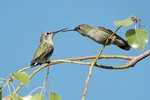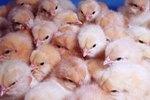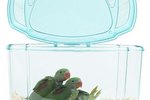
Budgies, or budgerigars, are small Australian parrots. Their natural coloration is light green, though pet industry breeding has created some color mutations. It's best to let the parents raise the chicks, but occasionally the parents will abandon a chick or even the whole clutch. If this happens you must find foster parents for the chicks, or hand-rear them.
The Brooder
Young budgie chicks are kept warm by their mother. Hand-reared chicks require an ambient temperature of about 98 degrees Fahrenheit until their feathers grow in. You'll want a nesting box or brooder for this. Don't clean the nesting box while it contains hatchlings; clean it after the chicks develop feathers.
Formula
Purchase a hand-feeding formula specifically made for budgerigars. Carefully follow the directions on the formula container. Typically you'll mix powdered formula with sterile bottled water that's heated to 103 degrees Fahrenheit. The ratio of water to formula is determined by the age of the chicks. For proper digestion, the formula temperature should be 98 degrees Fahrenheit. Keep the formula warm during feeding by placing it in a bowl of hot water. Never heat the formula in a microwave; hot spots can occur and may burn the chicks. Discard any unused formula after each feeding.
Feeding Technique
Use a small needleless syringe or eyedropper to feed baby budgies. Formula for newly hatched chicks is the consistency of applesauce. Hold each chick in your hand with his back against your palm, supporting his head. Gently insert the dropper tip into the back corner of the chick's beak, and drip the formula into his mouth. Don't overfeed; his crop will fill out, but the skin shouldn't become tight. Don't let the food fill his throat. After feeding, carefully clean inside the chick's beak with a damp cotton swab. Bacterial growth can occur if uneaten food is left inside his beak.
Feeding Schedule
Follow the formula directions for feeding schedules, and allow the chick's crop to empty between feedings. Feed the chicks every 1 to 2 hours, day and night, for the first few days. Gradually increase the times between feedings as your chicks grow. Three-week-old budgies will eat about four times a day. Budgerigar chicks should gain weight every day. For the first two weeks of life, healthy chicks gain 15 percent of their body weight daily.
Weaning
Provide fresh water, budgerigar seed mix, millet spray and cuttlebone when the chicks are about 4 weeks old. Begin introducing them to fresh fruits and vegetables now. Remove any uneaten produce at the end of the day. Budgies enjoy leaf lettuce, kale, parsley, broccoli and strawberries. Continue offering them formula until they're about 6 weeks old and are eating well on their own.
Fledging
Budgie chicks are fully feathered at around 4 weeks old. They're beginning to explore the world and attempting to fly. They'll sit on perches and flap their wings, exercising the wing muscles as they prepare for flight. Provide a safe place for your budgie chicks to fly. Protect them from windows, fans, poisonous plants and household pets.
References
Resources
Photo Credits
-
Duncan Smith/Photodisc/Getty Images
Writer Bio
Karen Mihaylo has been a writer since 2009. She has been a professional dog groomer since 1982 and is certified in canine massage therapy. Mihaylo holds an associate degree in human services from Delaware Technical and Community College.




